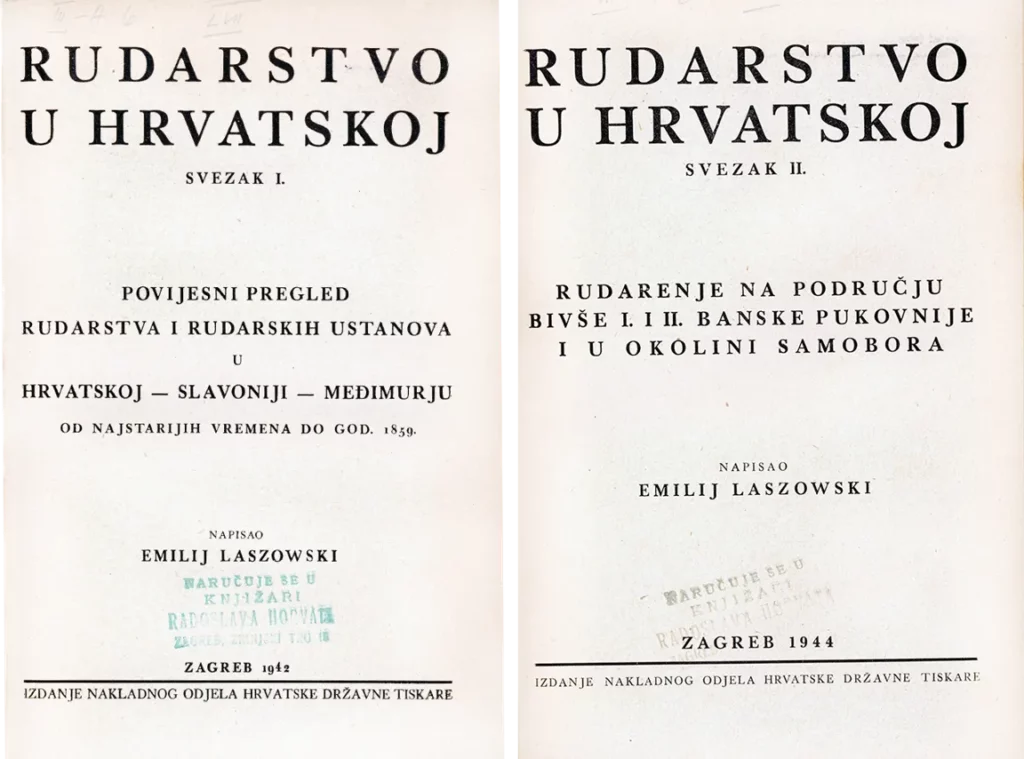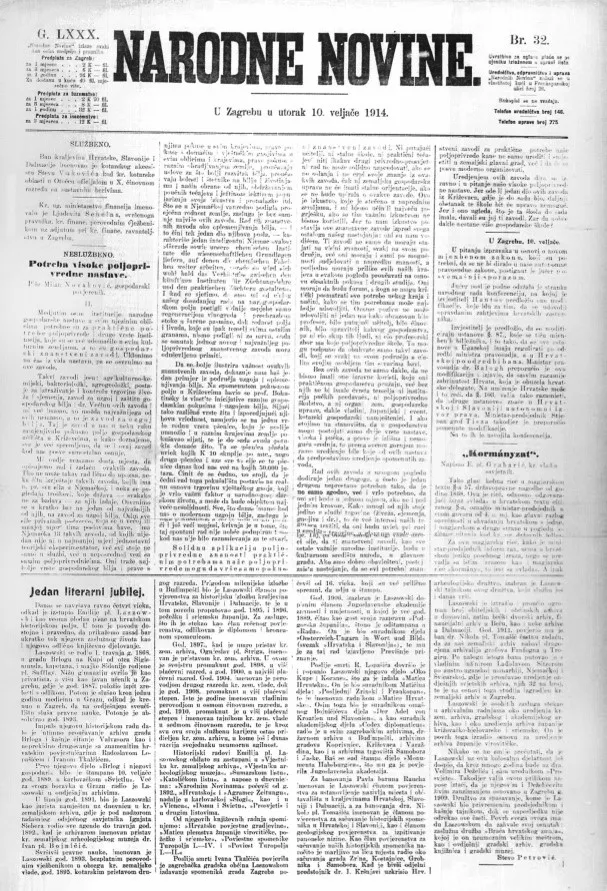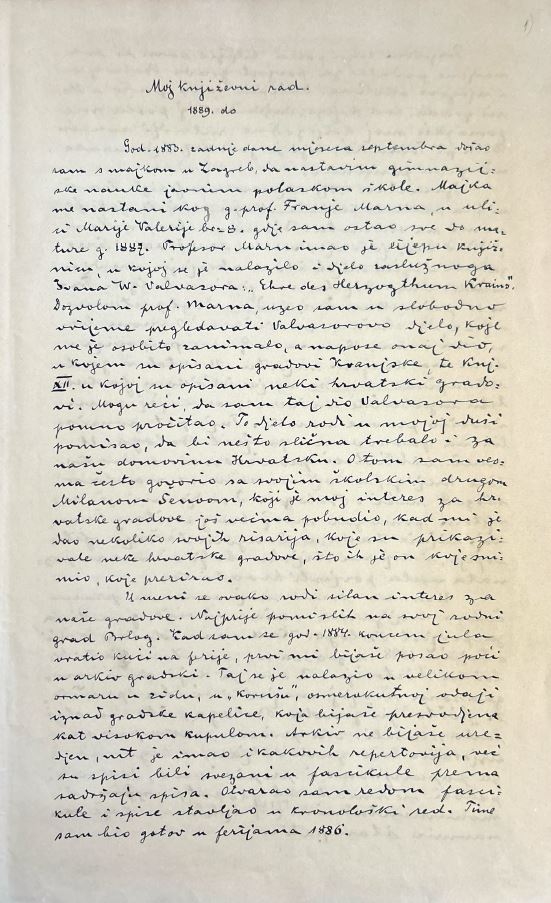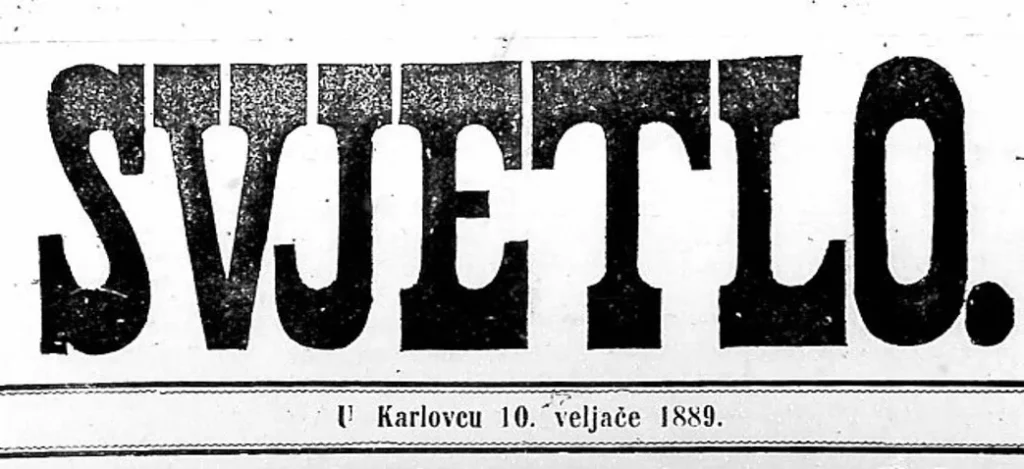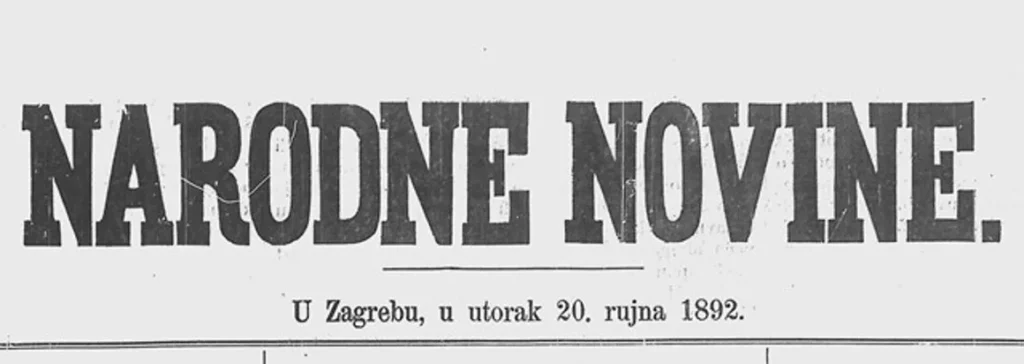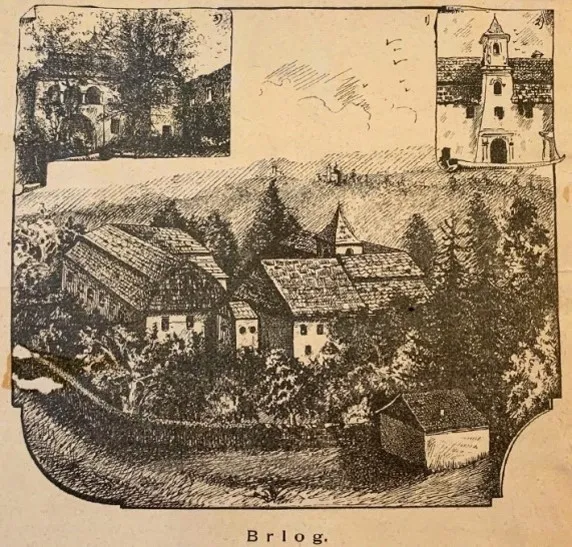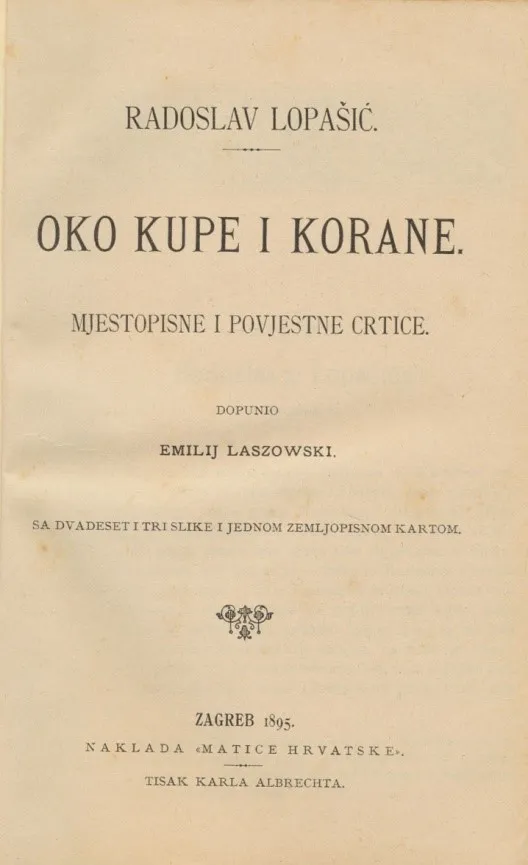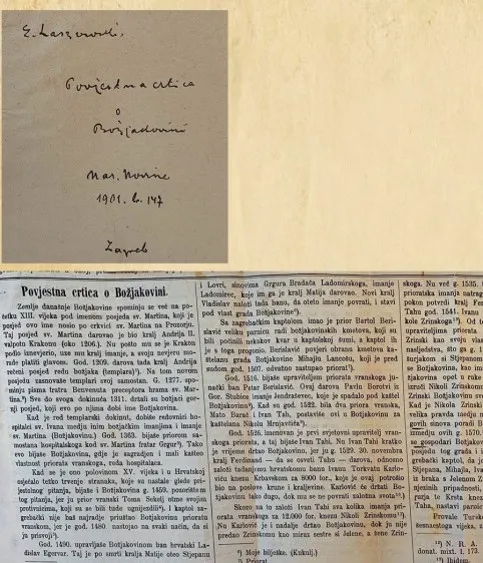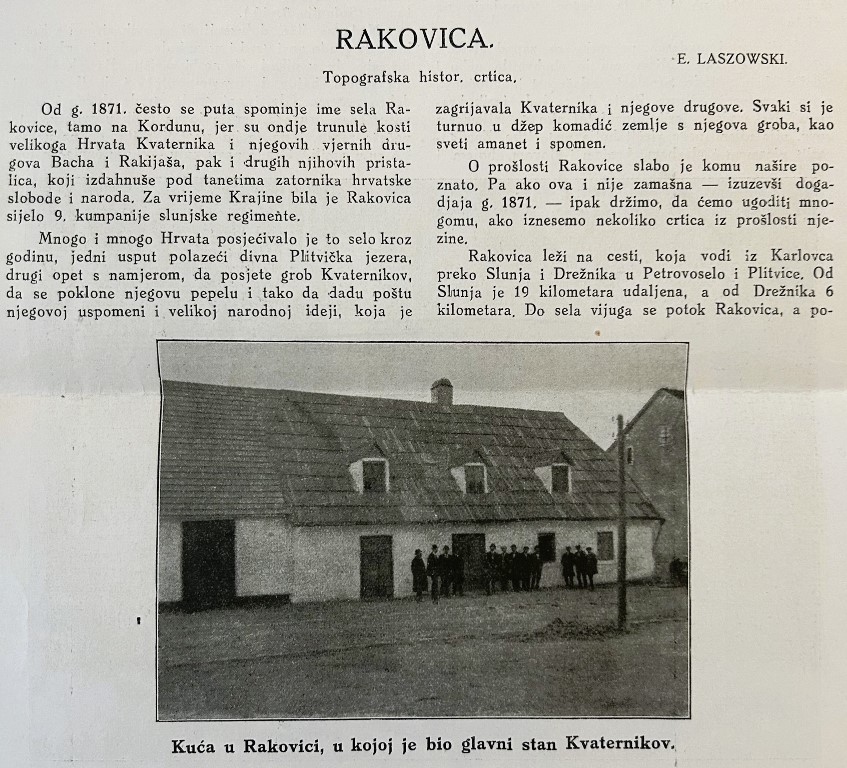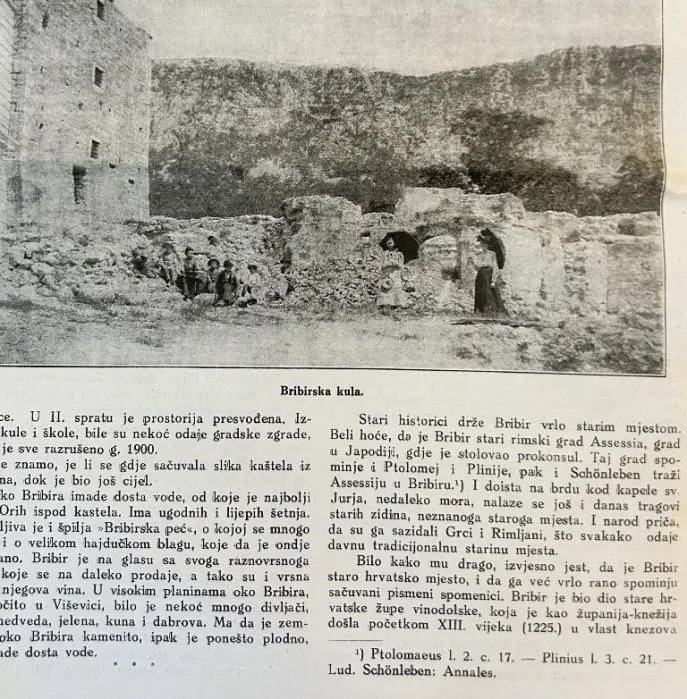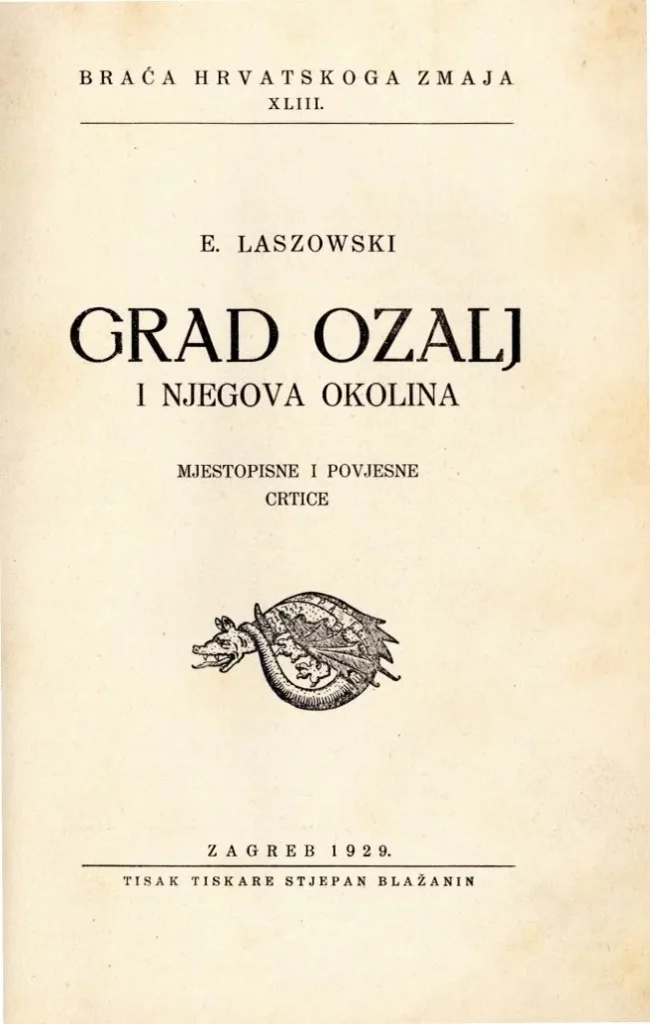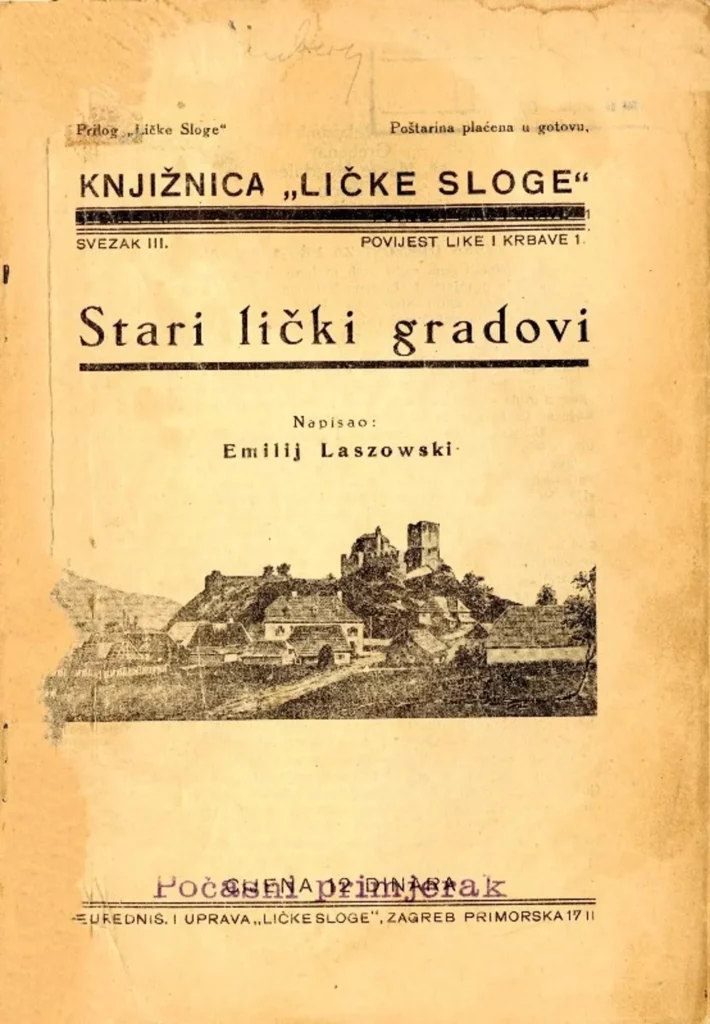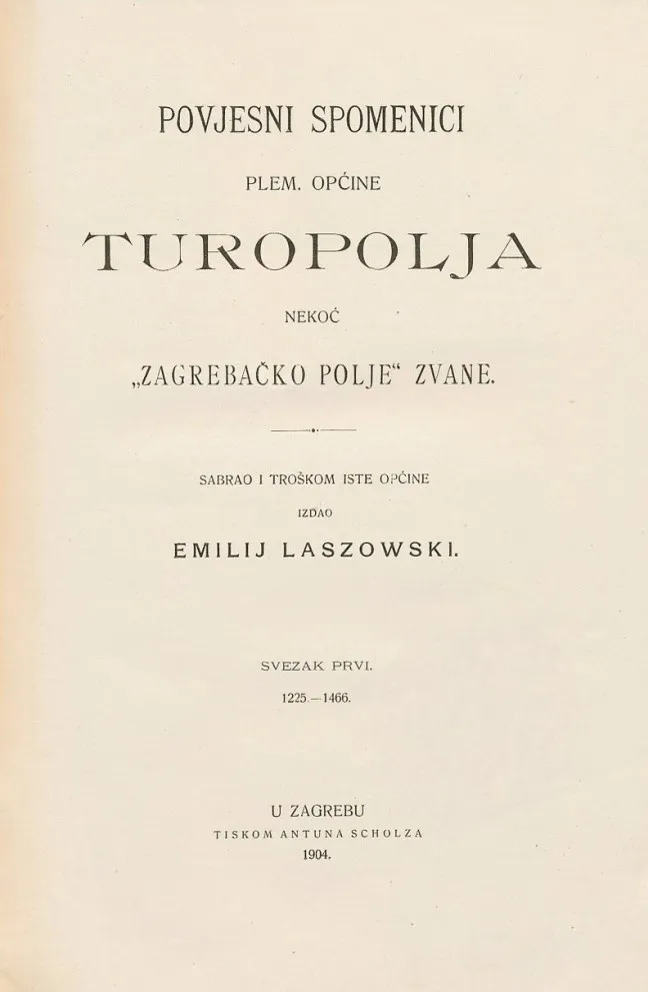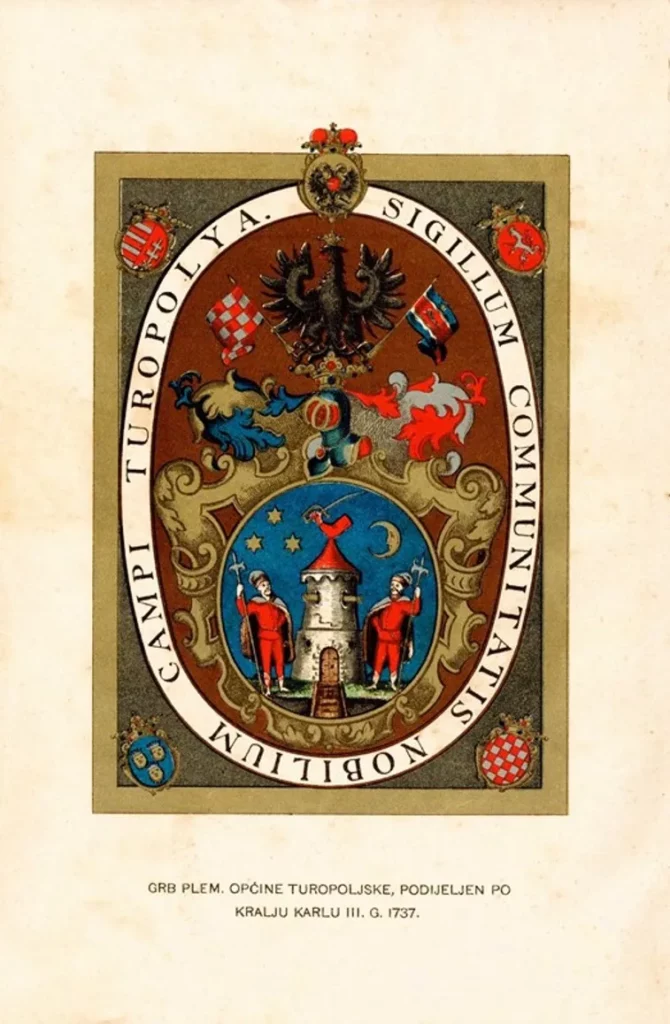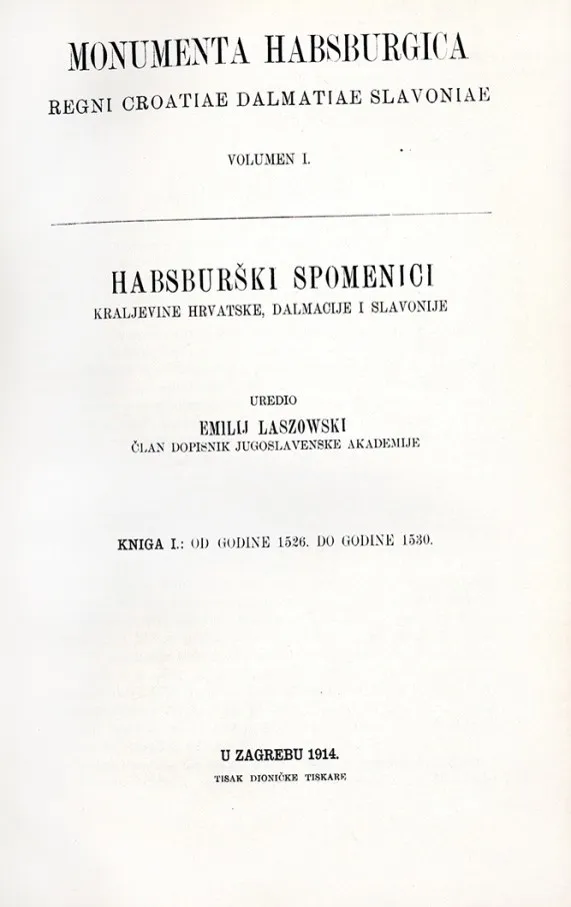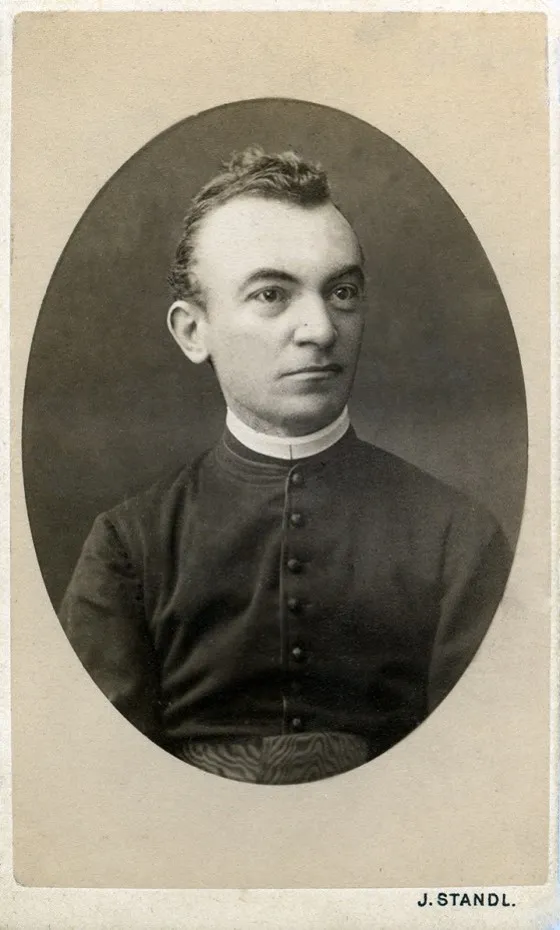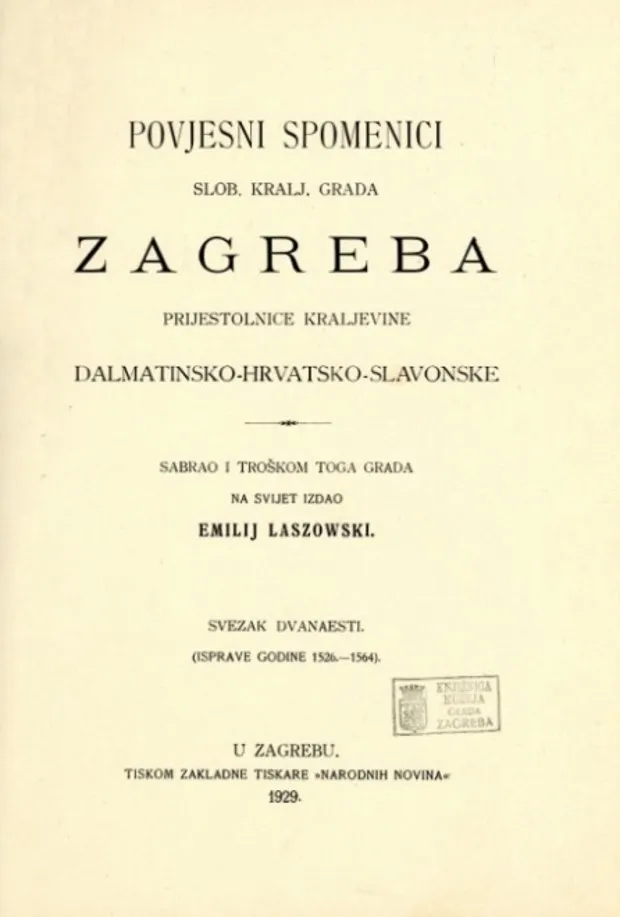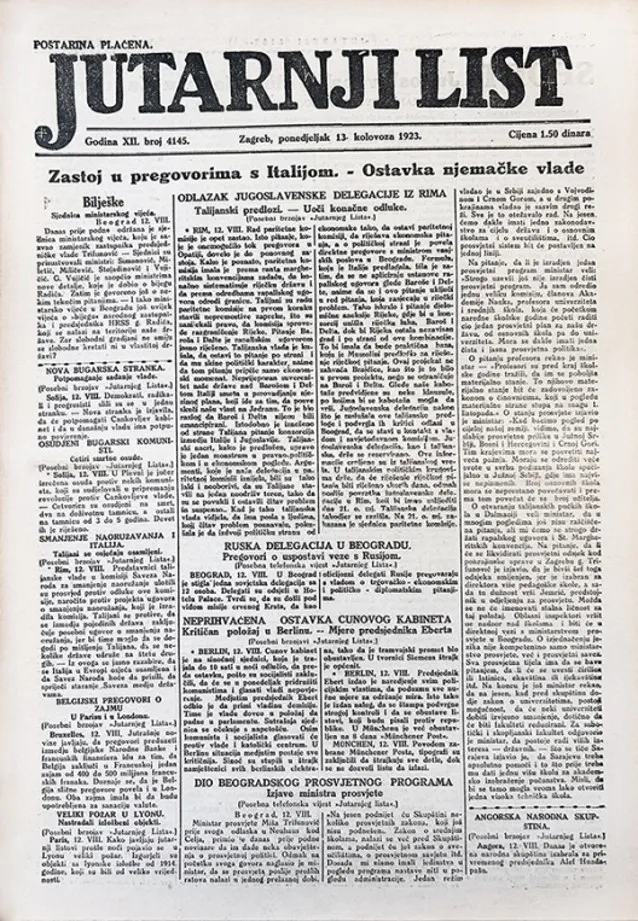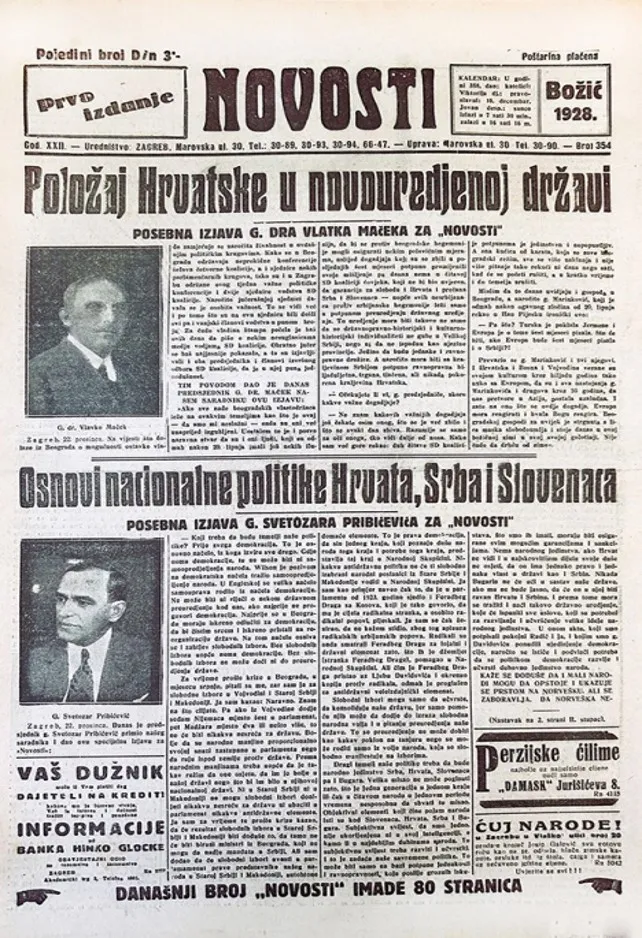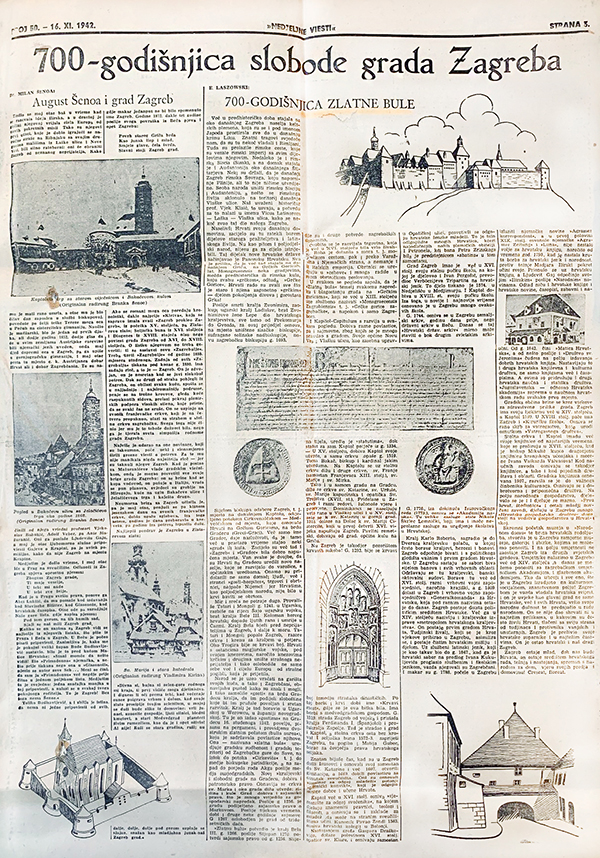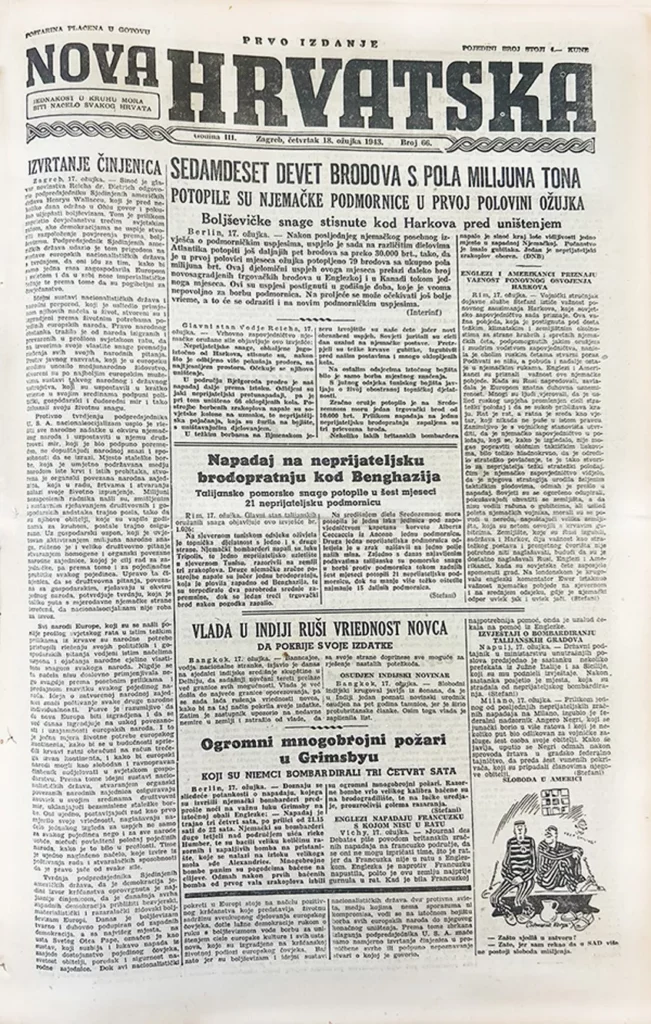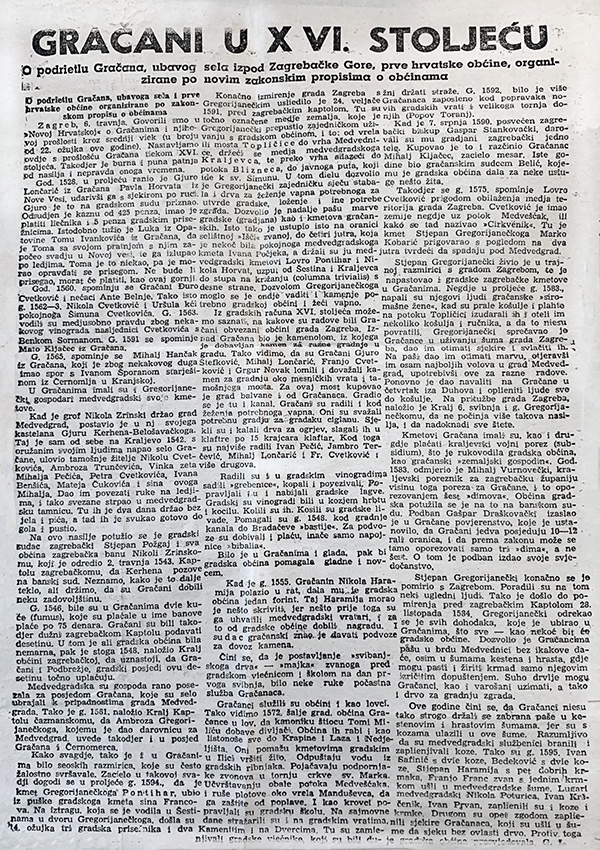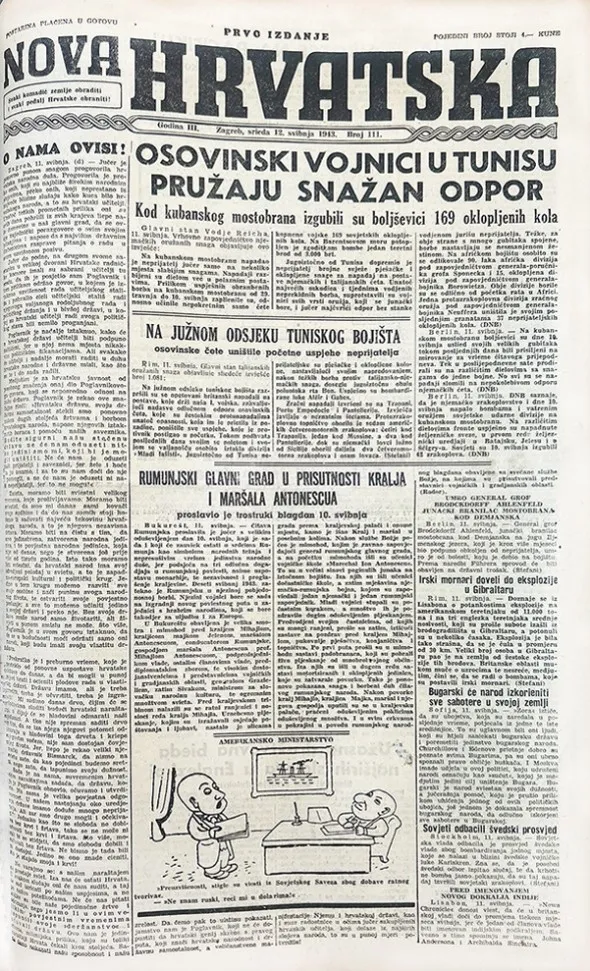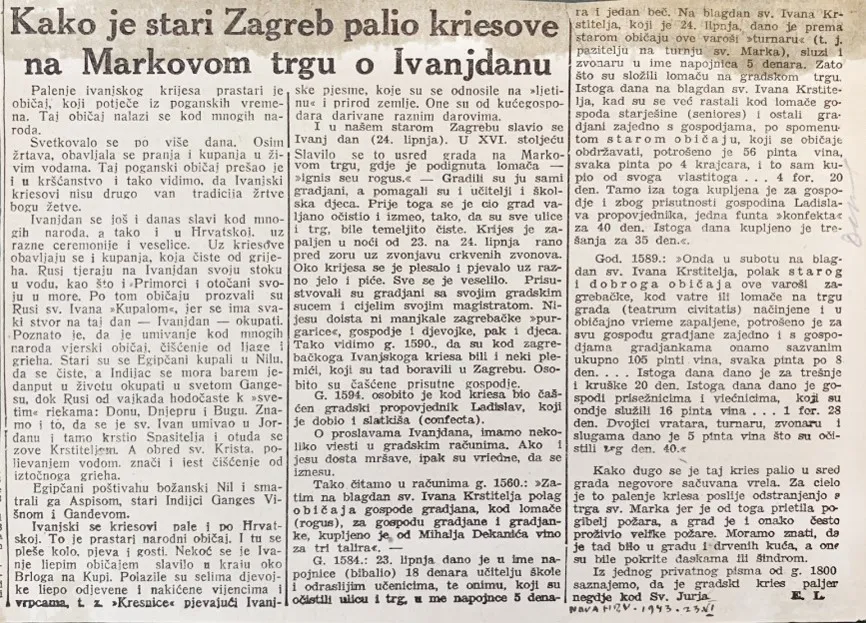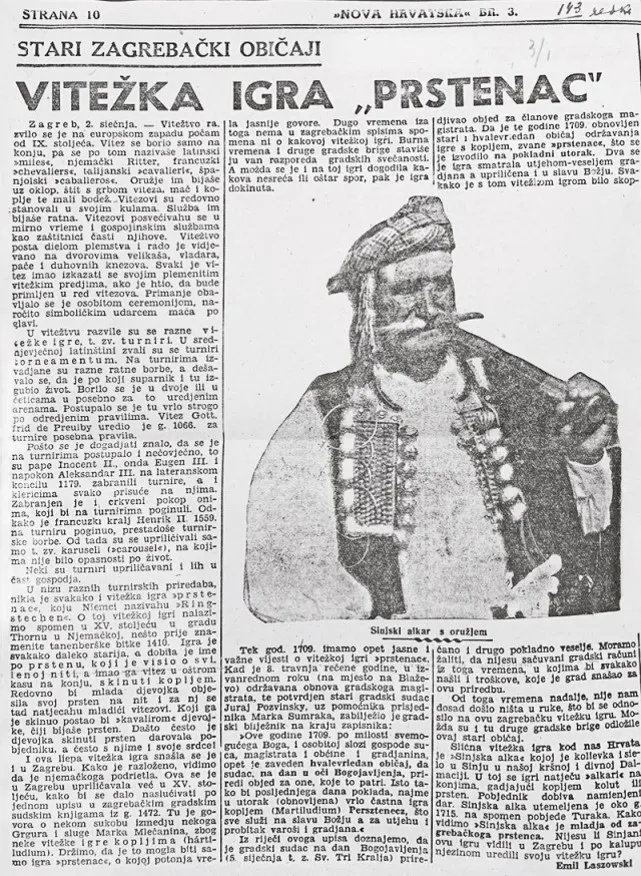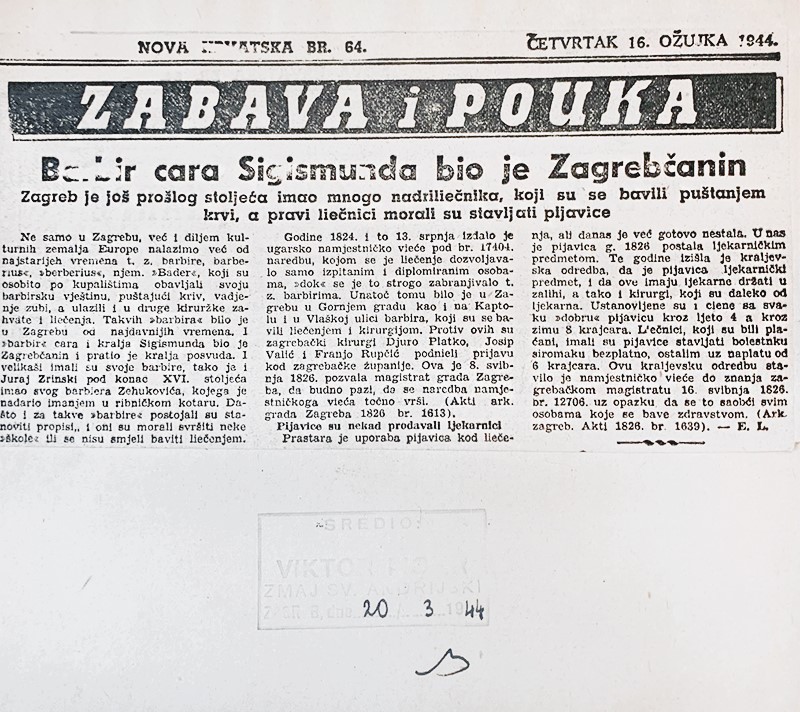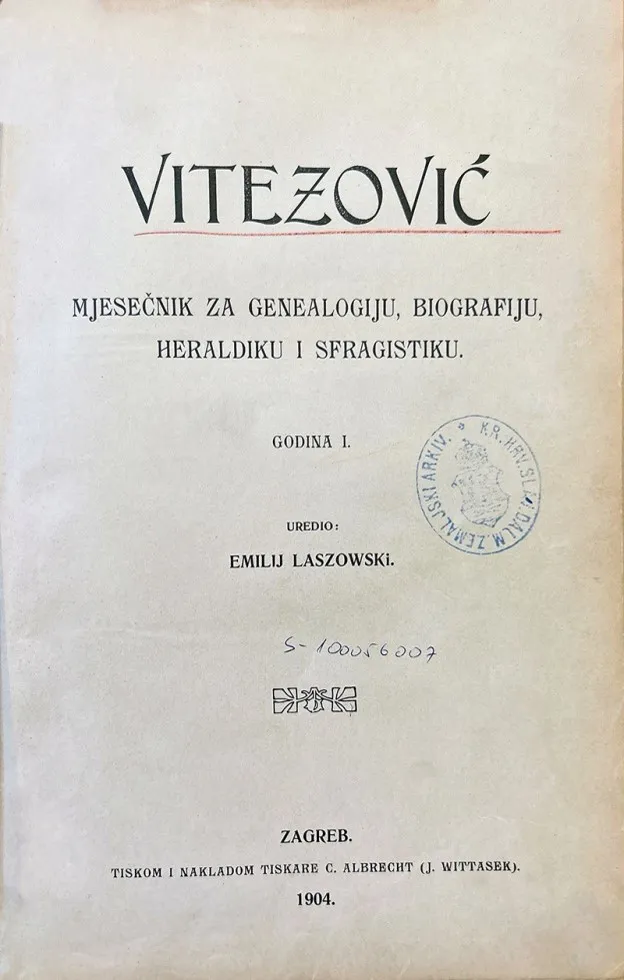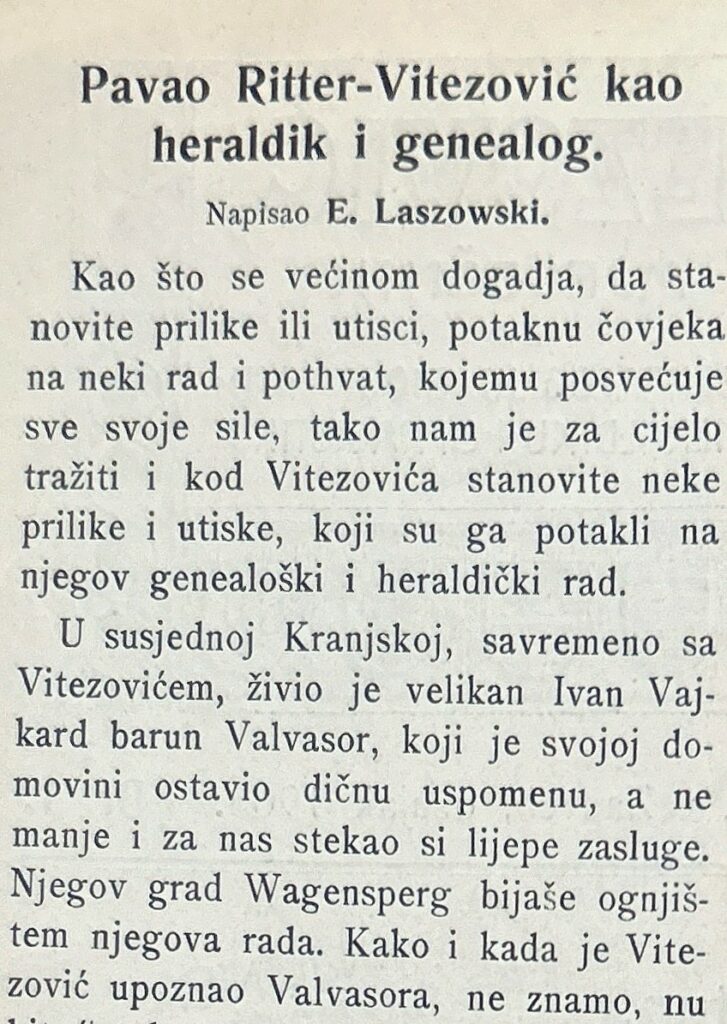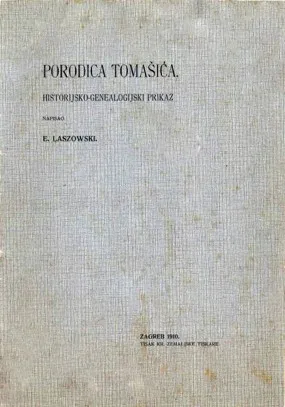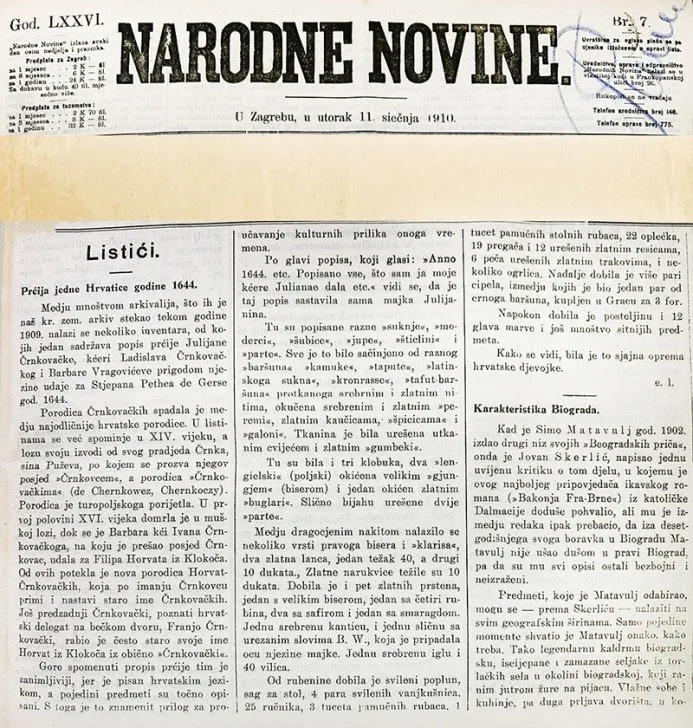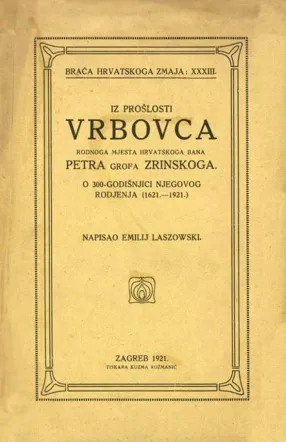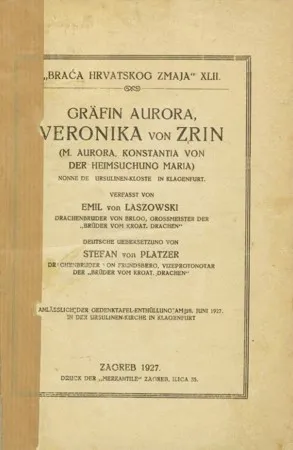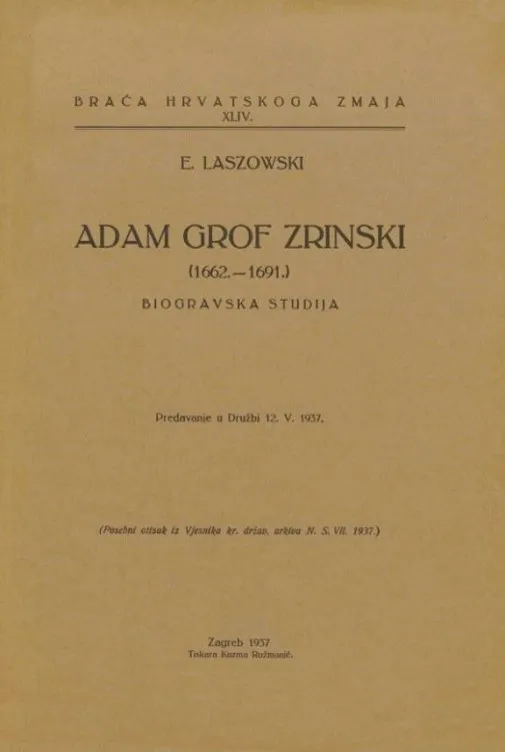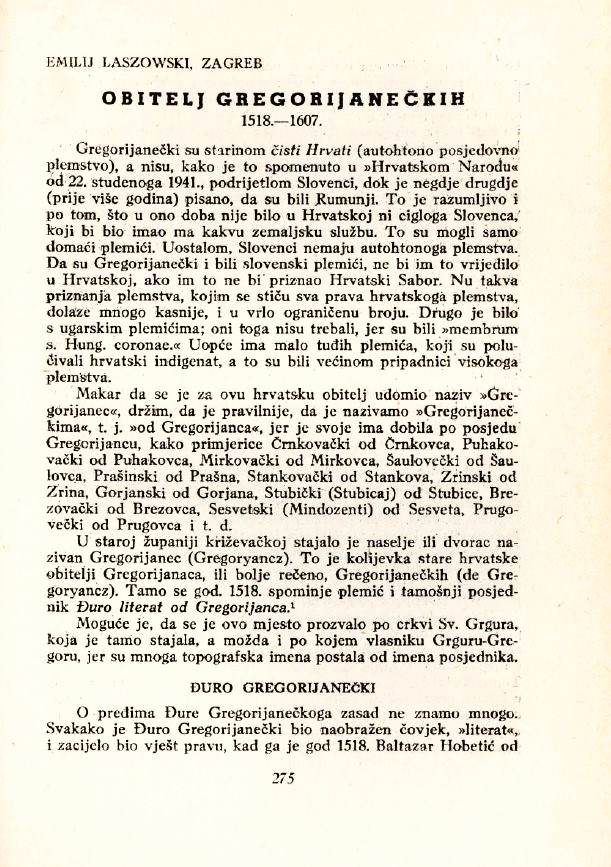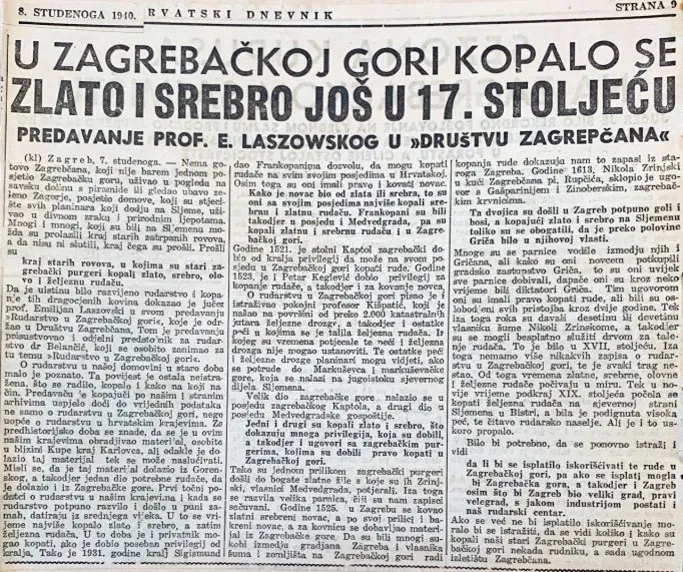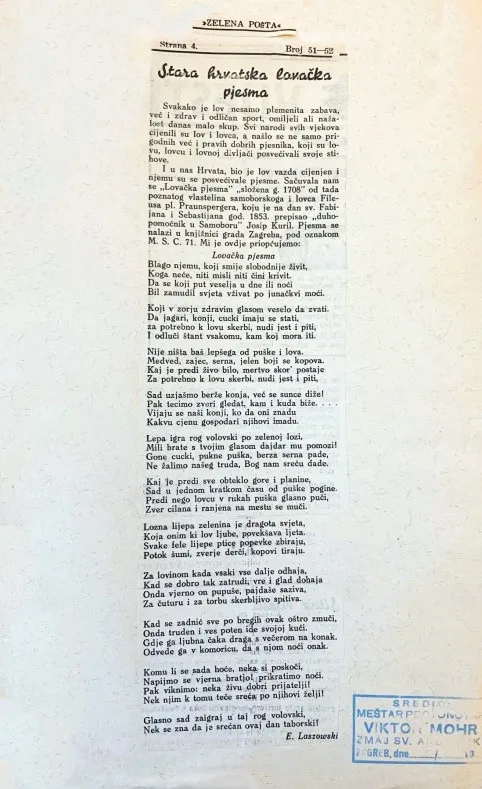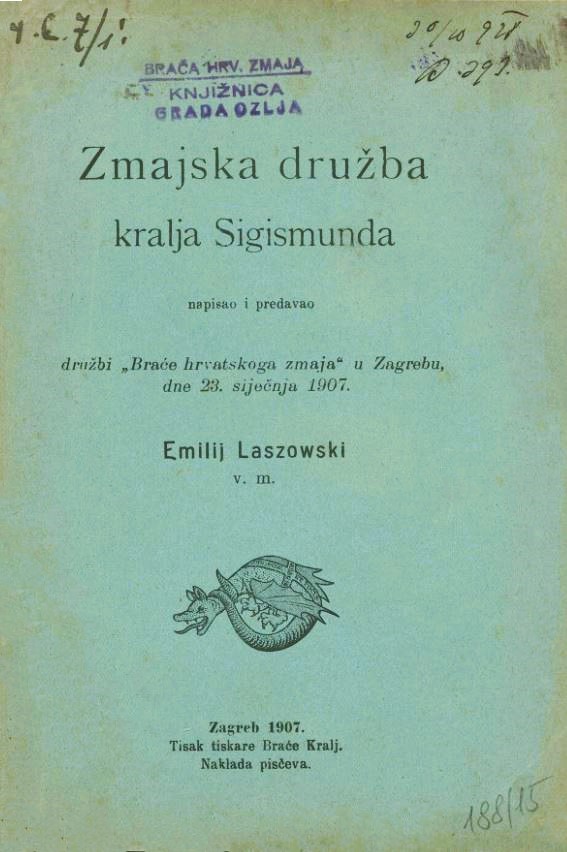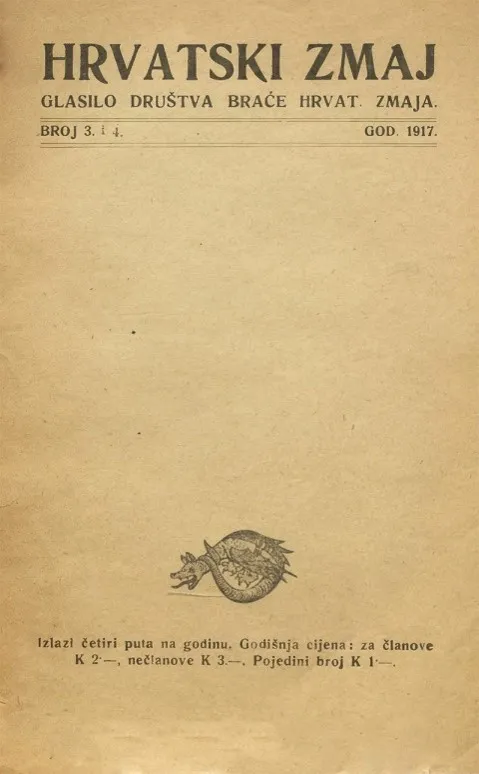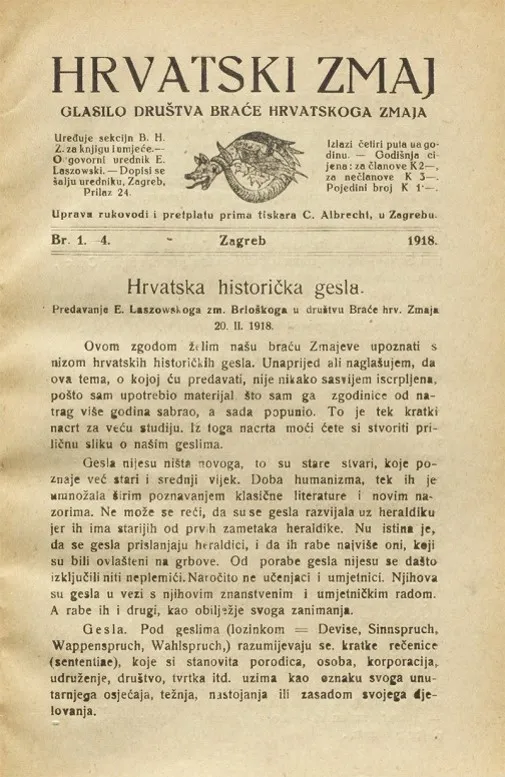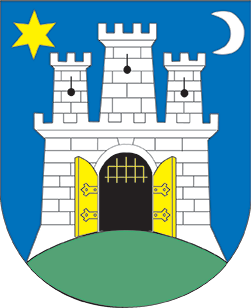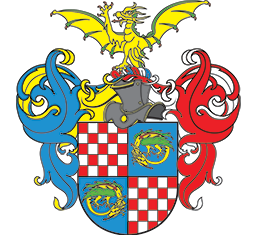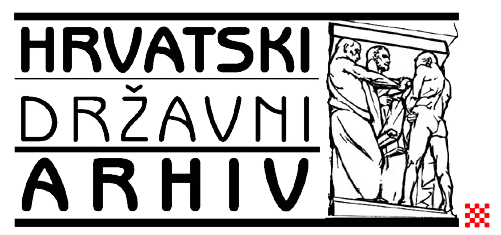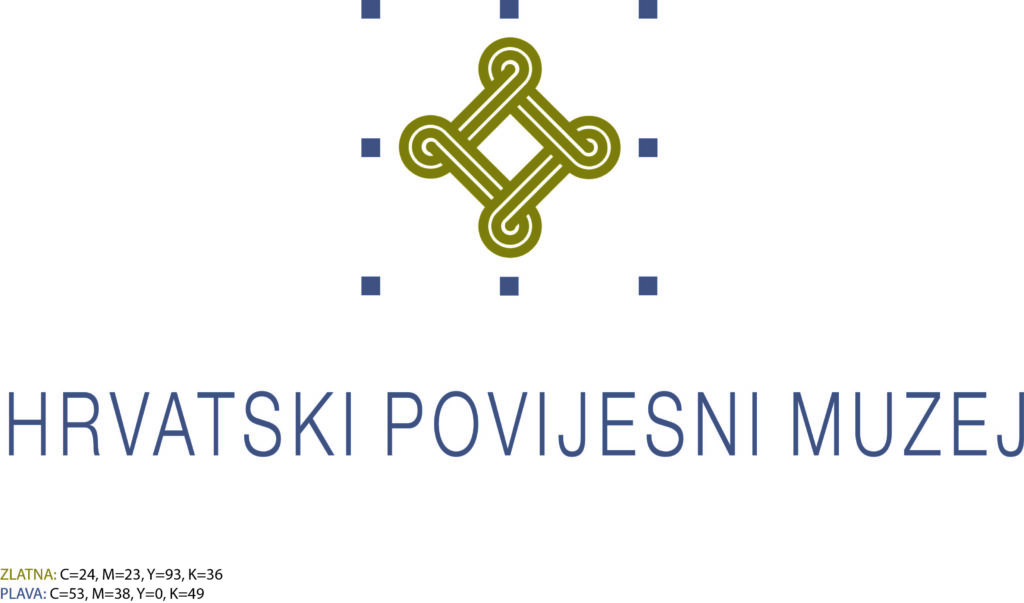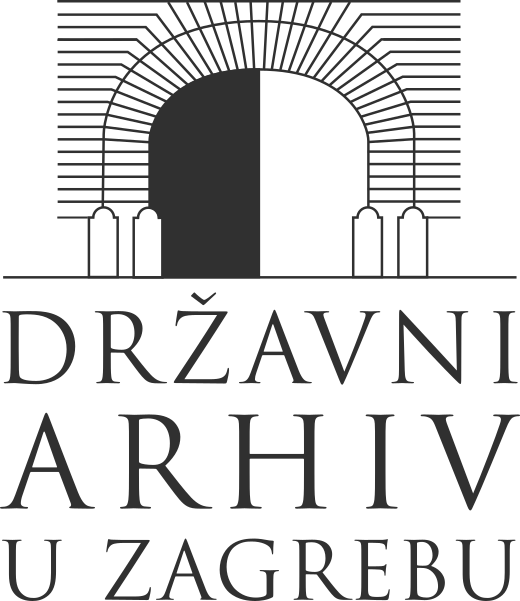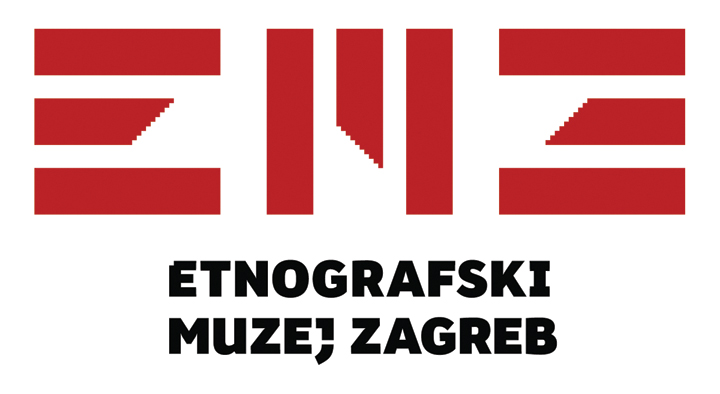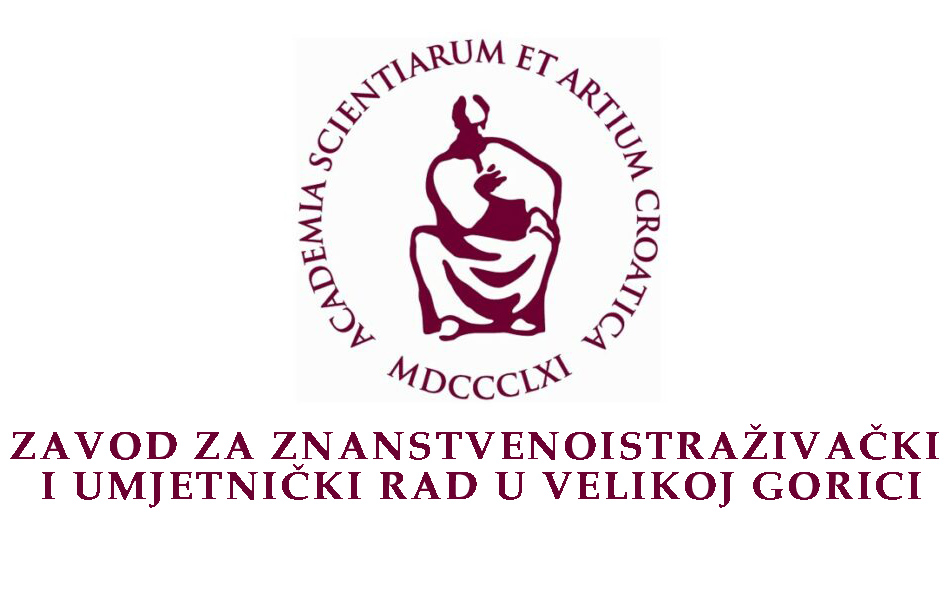14. My literary work
Working tirelessly in all fields especially in writing, Laszowski created all his life and published for 64 years. Emilij Laszowski’s personal fond in the Croatian State Archives is full of manuscript legacies (Diaries, autobiographical records, manuscripts, notes, scraps…), whereas his “literary” (publicist) body of work comprises 4,000 printed items – articles, notes, discussions, reviews and annexes, books and brochures. In fact, to this day it is not possible to establish their exact number and his bibliography is not yet complete. On the occasion of the thirtieth anniversary of Emilij Laszowski’s literary work, Velimir Deželić Sr. published a bibliography of his works.
According to the available lists, the first published work of the young Laszowski was an article with a historical theme, Brlog na Kupi i njegovi gospodari (Brlog on Kupa and its landlords), which was published in 1889 in three instalments in the Karlovac weekly newspaper Svjetlo. However, “off the record”, his first published work was a poem I love…, printed in 1885 in issues 23-24 of the Zadar newspaper Iskra, publication of which he either did not know about or did not care.
14.6: Brlog na Kupi i njegovi gospodari
Emilij Laszowsky // Svjetlo, 1889
The paper was published in issues dated February 10 and 24, and March 3, 10, 17 and 31, after which it was not finished.
NSK
The first work for which he received payment was a historical overview of the development of the town of Ribnik, published in 1892 in the Official Gazette. Laszowski dedicated it to J. Gáll and his wife, probably the person who commissioned the text, who being delighted with the piece rewarded him with 20 forints. In 1893, he published it as a brochure Ribnik: historička studija (Ribnik: a historical study).
14.7: Ribnik
Laszowski // Narodne novine, 1892
It was published in ten instalments, from the issue number 214, dated 20 September, to number 230, dated 8 October, 1892.
NSK
He wrote because he wanted to, but also because he needed to – to provide for himself and his family. With great energy and considerable private and professional interests, he wrote about everything, but mostly about the history of Zagreb, families of Zrinski and Frankopan, Croatian historical toponyms and heraldry. Growing up and being brought up in the historical town of Brlog next to Ozalj must have “propelled” Laszowski towards historical topics, and later on the giants of Croatian historiography – Radoslav Lopašić, Ivan Krstitelj Tkalčević and Tadija Smičiklas had a huge influence on his formation as a historian.
14.8: Work desk of Emilij Laszowski
Photographer unknown, circa 1920
In: ELS
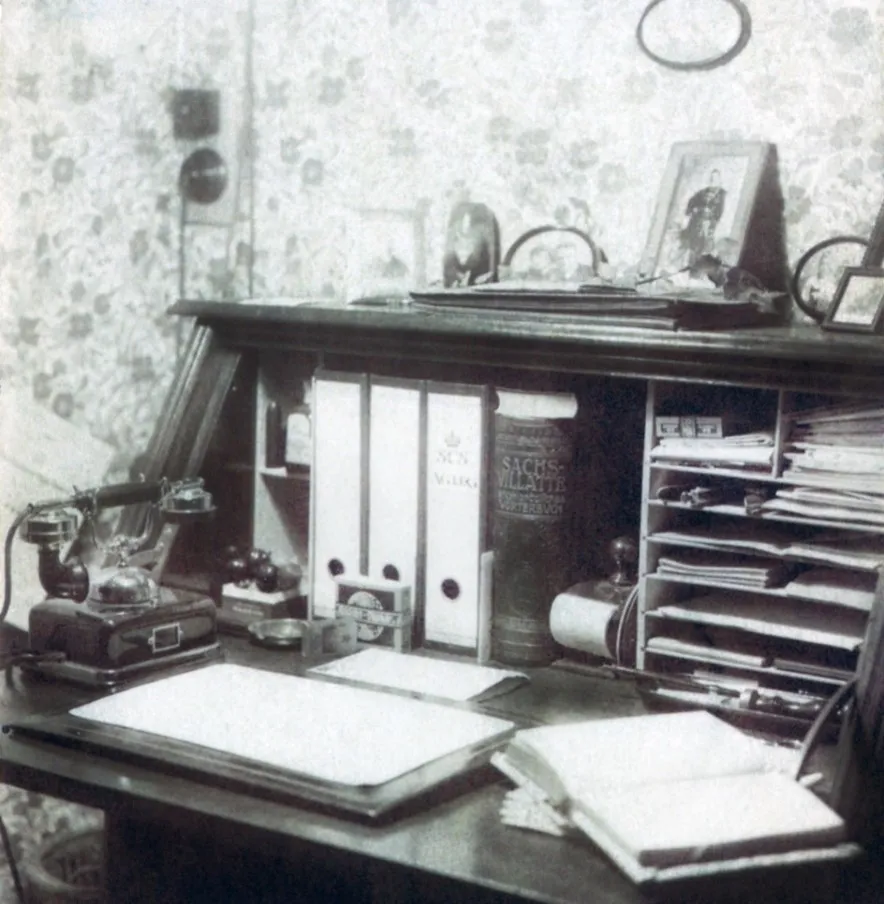
14.1: Throughout our beloved homeland
The first decade of his publicist activity was largely marked by “local” works, i.e. texts about the toponyms of the Croatian history – forts, towns, castles, first about those near his hometown, and then throughout Croatia. He wrote about many places throughout his homeland, for example about Domagović, Bubnjarci, Lipovac, Desinac, Oštarija near Ogulin, Modruš, Brinje, Hreljin, Ilok, Bosiljevo, Cetin, Novigrad, Belaj, Ogulin, Zrin and Kraljevica, Tounj and other. In 1902, he crowned his enormous contribution to the revival of forgotten, and important, places and regions of Croatian history with publication of the first volume of Hrvatske povijesne građevine (Croatian Historical Buildings).
14.1.1: Hrvatske povijesne građevine
Emilij Laszowski / Zagreb, 1902
Laszowski planned to publish them in several volumes, but due to high printing costs and lack of funds, his work unfortunately stopped with publication of the first volume. In his paper he collaborated with J. Barlè, V. Deželić Sr. and M. Šenoa and published approximately thirty descriptions of towns, monasteries, churches and fortresses.
MGZ
14.2: Titus Livius of Turpolje
Due to being preoccupied with other topics and projects, in the first two decades of the 20th century Laszowski no longer published too many “local reports” in the newspapers and magazines. Yet again, probably two of his most significant works were created in that period. From 1904 to 1908, he independently collected and edited a four-volume collection of archival sources Historical monuments of the noble municipality of Turopolje formerly known as “Zagrebačko polje”, and two years later, from 1910 to 1924, based on these sources, he wrote and published the history of the municipality in three volumes, History of the noble municipality of Turpolje formerly known as Zagrebačko polje. Laszowski was invited to participate in that engagement by the Turopolje prefect Ljudevit Josipović, and the municipality generously financed the entire publication of the work, as well as Laszowski – who was interested in the history of Turopolje, but also in need of an additional source of income. The noble municipality of Turopolje was the only one in Croatia that could claim such works and Laszowski was nicknamed “the Titus Livius of Turopolje” by August Šenoa.
14.3: The best reader of old documents
The reasons for Laszowski’s great contribution to the publication of archival sources are multiple – first of all, his determination, being present at the source, and his knowledge of the Latin language certainly did not incumber him. Velimir Deželić Sr. wrote as follows:
…to the “monster of a child”, from Brlog who speaks better Latin at the age of six than the old Latin scholars. I met that monster afterwards. It was my dear Emilij. That hell of a knowledge helped him tremendously and today he is one of the best readers of Latin documents and charters.
Alongside his work on Turopolje sources, from 1896 to 1914 Laszowski collaborated with Tadija Smičklas on the collection, editing and publication of a collection of documents Diplomatic Collection of the Kingdom of Croatia, Slavonia. He independently collected and edited the collection of documents Habsburg Monuments of the Kingdom of Croatia, Dalmatia and Slavonia, published in three volumes from 1914 to 1917.
In addition to Diplomatic Collection, Laszowski inherited another large periodical collection of sources, which were Historical Monuments of the free royal city of Zagreb, the capital of the Kingdom of Dalmatia-Croatia-Slavonia. After the death of Ivan Krstitelj Tkalčić, who by then had edited 11 volumes, according to his wishes, the city of Zagreb assigned this work to Laszowski who from 1929 to 1949 collected, organised and published Zagreb’s archival materials from the 16th and 17th centuries in seven volumes.
14.4: Cultural and historical notes on Zagreb
Laszowski was a true historian of Zagreb. He fell in love with Zagreb’s past thanks to his role model and friend Ivan Krstitelj Tkalčić. Continuing his work, studying and writing about Zagreb, he remained in memory of wider social circles precisely because of this. In his writing about Zagreb, he covered a wide variety of Zagreb’s historical and cultural topics. His most significant piece of legacy in this field is titled Old and new Zagreb: historical and cultural-historical notes about Zagreb, published in 1925 by the “Brethren of the Croatian Dragon” Society. He was the writer, co-ordinator and editor, and out of 92 texts, he was the author of 60 of them. The work was published in bundles every 14 days, and a total of 10 bundles in 7 parts were published. Collection From the old and new Zagreb, published by the Museum of the City of Zagreb can be considered a sort of an homage to this work.

14.4.1: Front page of the bundles Stari i novi Zagreb
Edited by E. Laszowski / Zagreb, 1925
MGZ
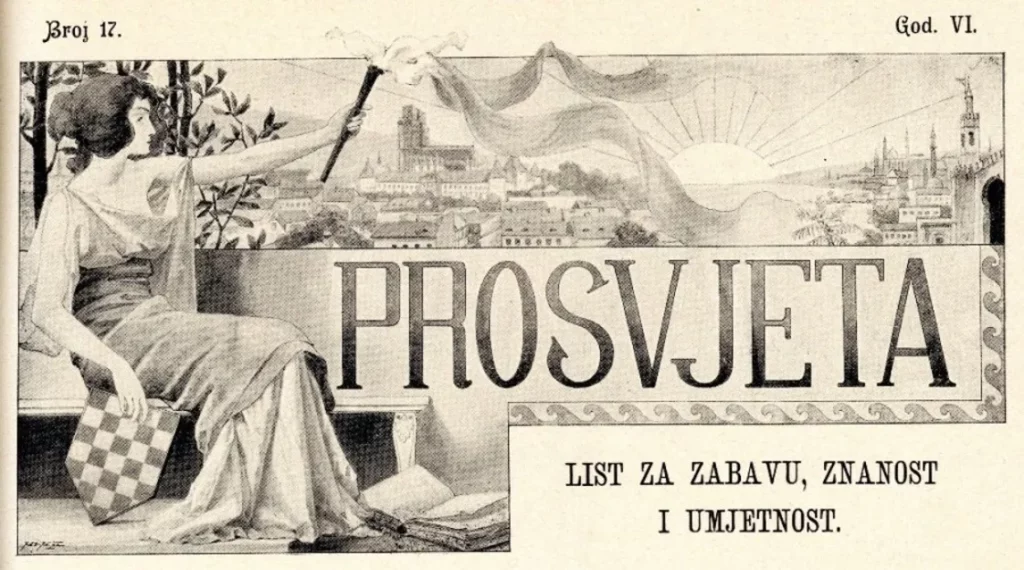
14.4.2 – 5: A selection of Zagreb-themed articles published in the magazine Prosvjeta
Emilij Laszowski, 1896 – 1906
MGZ
14.4.2: Zastave grada Zagreba, 1896
14.4.3: Krčelićeva knjižica, 1898
14.4.4: Plan Zagreba, 1900
14.4.5: Slike iz starog Zagreba, 1906
14.4.6 – 9: A selection of texts published in the magazine Vjestnik Kr. hrvatsko-slavonsko-dalmatinskog zemaljskog arkiva
Emilij Laszowski, 1900 – 1915
MGZ
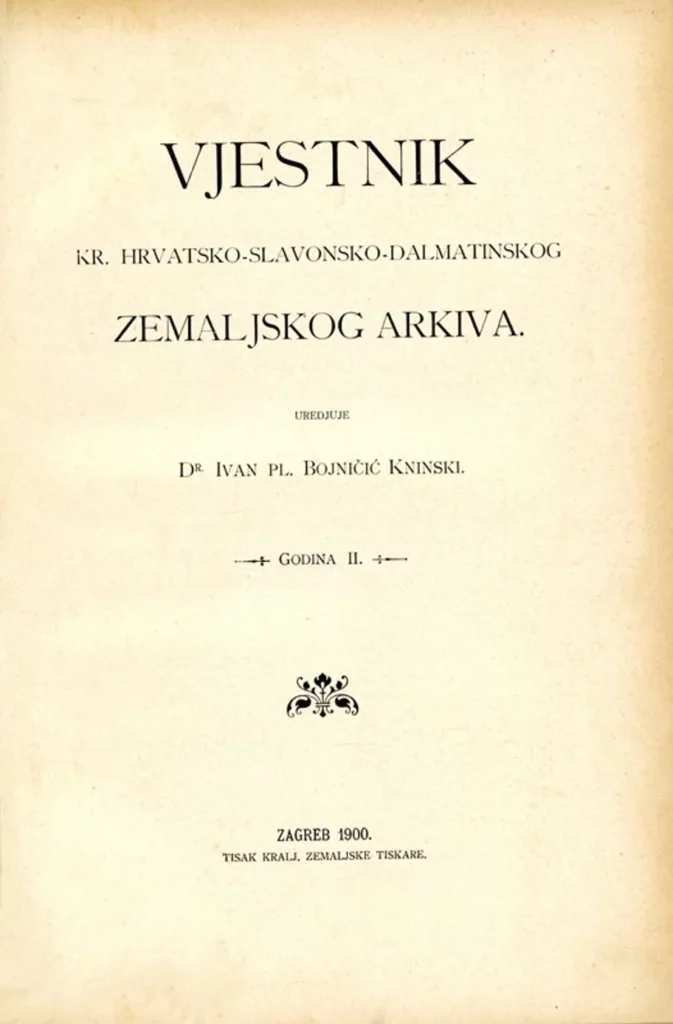

14.4.10 –14: A selection of texts published in the magazine Narodna starina
Emilij Laszowski, 1922 – 1925
HRČAK
14.4.15 – 26: A selection of texts published in the magazine Zagreb – revija Društva Zagrepčana
Emilij Laszowski, 1935 – 1942
MGZ
14.4.15: Sukobi hrvatske mladeži sa austrijskim časnicima u Zagrebu 1834.,1935
14.4.16: Mesnička vrata u starom Zagrebu, 1936
14.4.17: 24. lipnja i Ivanjski kresovi, 1936
14.4.18: Gradska vrata i kula “Dverce, 1936
14.4.19: Buntovnički spis „Fama volat“ u Zagrebu g. 1769., 1936
14.4.20: Turopoljski plemići Krupići u Zagrebu, 1937
14.4.21: Zagreb s arheološkog gledišta, 1938
14.4.22: Krađe u stolnoj crkvi zagrebačkoj u XVII stoljeću, 1938
14.4.23: O topografiji Kaptola 1642., 1940
14.4.24: Prilog poviesti regulacije Bakačeve i Vlaške ulice, 1941
14.4.25: Josip pl. Šufflay, profesor zagrebačke akademije, 1942
14.4.26: 700-godišnjica slob. i kr. glav. grada Zagreba, 1942

14.5: I had a town, a coat of arms and a title
A nobleman himself, he loved to study history and genealogy of the Croatian nobility, biographies of eminent and distinguished persons, and he was interested in heraldry and sphragistics and his work was plentiful in all these areas. He started a magazine Vitezović in 1903 with his own funds, of which he was an editor until 1905 when it was shut down due to lack of subscribers despite the fact that it was much needed only by a narrow professional circle.
14.6: A wide array of interests
It would be impossible to classify everything that Laszowski was interested in and that he wrote about into just a few categories – largely due to his own curious nature and interests, and some of the work was commissioned. He also dealt with economic topics, primarily historical development of mining, having written two volumes of Mining in Croatia. He wrote about the history of sheep farming, Croatian ports, Armenian literature… He also published papers about archives and the archival profession, about his private life, but also about the Society. He also tried his hand at literary creation – most of which is scattered in manuscripts, but some have been published, such as the work The unfortunate woman. A story from life was printed in the calendar God and Croats. It is difficult to list everything. Aside from his magazine Vitezović, he also edited others – Education, Journal of the Royal State Archives in Zagreb, Croatian Dragon. It would be an exaggeration to say that everything he wrote was brilliant, but it is certain that he based all his work on authentic archival records and to that extent along with its astounding amount and extensiveness his work has a lasting value.
